#seaweed salt sesame topping
Explore tagged Tumblr posts
Text

It’s a little full, but I think this is my best looking one yet!
#journal entry#food#ramen#I think the whole thing maybe cost $5 in total?#bacon#eggs#sriracha#seaweed salt sesame topping#seaweed snacks#green onions/scallions#garlic#ichiban tonkotsu ramen#mushrooms#also threw in some garlic and chili oil#food porn
52 notes
·
View notes
Text
actually yknow what, no. this is not being limited to discord, yall get it too.
some general cooking tips (in which there is a brief senshi posession):
moisture is the enemy of crispy skin. pat dry with paper towel, and if you have the time and spoons, give a thorough but even coat of baking powder and let sit uncovered in your fridge overnight. this will dry out the skin nicely. for pork belly, create a tight foil boat so that only the skin is showing, and cover in salt to draw out moisture, repeating a couple times if necessary.
furikake seasoning, for the fellow rice lovers, is just nori (seaweed), sesame seeds, sugar, and msg/salt. you might have most if not all of these things already in your kitchen.
chai spice mix is just cinnamon, ginger, cardamom, cloves, nutmeg, & allspice.
pumpkin spice is just cinnamon, nutmeg, cloves, and ginger.
to cure your own bacon, you only need water, white and brown sugar, and a non-iodized salt - himalayan pink salt is not iodized, if you cannot find butchers curing pink salt. from there, you can add any seasoning/flavoring you want.
the truly adventurous may cook their rice in green tea for a fresh clean taste.
you can tell if a fish is truly fresh by their eyes - clear and bright is fresh, while cloudy is older or potentially has been frozen.
it's cheaper to buy a large block pack of ramen from your local asian market and repackage the bricks into sandwich bags, than to buy a box of individually packaged ones such as maruchan or top ramen.
when buying meat, look at it's fat content - more fat marbling usually means more tender + flavorful.
you can save onion skins and other vegetable scraps to make your own broth with. you can also save bones for this. mix and match ratios to create your ideal flavor.
bay leaf will always make a soup or broth taste better, but Watch Out (they are not fun to bite into on accident).
msg is, in fact, not The Devil, that was just a racist hate campaign against the chinese and other oriental races. it's literally just a type of salt. it is no more dangerous to eat than any other type of salt.
washing your rice is important because it not only improves flavor and texture by removing excess starch, but it also helps reduce any residual pesticides or dirt, or even insect fragments (please remember that rice paddies are essentially giant ponds that all kind of things live in and swim around. you should also be washing all your produce in general.)
please salt your cooking water for pastas, it just tastes better and you will be happier for it.
boiled potatoes are also improved by salt water.
if you hate vegetables, please consider trying them fried in butter or perhaps bacon grease. it is healthier to eat them fatty than not at all.
healthy food does not in fact have to taste miserable. thats a lie. they are lying to you. free yourself from your blandness shackles. enter a world of flavor.
10K notes
·
View notes
Text


Made some Tuna and Mayo rice balls--18 plus one. :) Love this stuff.
#So easy to make#So tasty#I use a little salt and sesame oil instead of vinegar or whatever to season the rice#And just mix a thing of canned tuna with a dollop of mayo#A little bagel seasoning (or rice seasoning or sesame seeds) on top wrapped with seaweed#And you're done#Super super easy and delicious#Lamia-lmiae cooks
0 notes
Text
Hey guys. Rice ball time.
Things you need:
Sushi rice
Mirin (technically optional)
Rice wine vinegar
Sesame oil (technically optional)
Seaweed wraps (technically optional)
Salt
Filling: I prefer spicy lemon mushrooms or spam with prosciutto, but you can use basically anything you want here. Cheese, taco meat, spinach and feta, take your pick.
Equipment/supplies you need:
Rice cooker
Frying pan
Spatula
Spoon
Plastic wrap
Cookie sheet (technically optional)
STEPS:
Measure the rice according to your rice cooker.
WASH THE RICE. This is important. It just means swirl it around in water with your hand, drain the water off, and repeat until your water's not getting any clearer.
Put in the rice cooker with water according to how your rice cooker works.
Add a splash of rice wine vinegar, + mirin and sesame oil if you have it.
Cook rice.
While rice is cooking, prepare filling however you want.
When both are done, take out a sheet of plastic wrap. Sprinkle generously with salt.
Scoop some rice onto the plastic wrap. About a fist-sized portion should be more than enough.
Put a spoonful of filling in the center.
Cover spoonful of filling with more rice.
Close up the plastic wrap and twist it. You should have a formless rice ball.
Shape it into a triangle by squeezing the plastic wrap. You might need a washcloth for heat protection for this.
Repeat until you're out of rice. Congrats, you have rice balls for the next few days.
Refrigerate until cold.
At this point, they should hold their shape fairly well. If you want to seaweed-wrap them:
Fill cookie sheet with warm water.
Have surface ready to put seaweed and rice ball on.
Submerge seaweed sheet in warm water for 10 seconds MAX.
Put flat on the surface from 2. It will be messy, that's fine.
Put rice ball in middle of seaweed.
Fold seaweed around it. I like to fold the corners over the top of the triangle first, then the bottom.
Wrap in foil and refrigerate.
Repeat for as many rice balls as you want like this.
SPICY LEMON MUSHROOM FILLING:
Cajun seasoning (paprika + oregano + thyme + salt + cayenne + white pepper + red pepper flakes. Paprika should be the biggest component, everything else, add as much as you think you want)
Lemon juice
Margarine or butter
Sliced mushrooms
Put in a lot of butter and let it melt.
Add the mushrooms.
Season generously with cajun seasoning.
When they look like they're properly cooked (dark, smaller, kind of curled in on themselves, shiny, the butter's mostly gone), add lemon juice.
Cook until lemon juice is mostly gone.
Profit.
SPICY LEMON SPAM FILLING:
The exact same as above except you cut up spam for it instead of mushrooms. Maybe add soy sauce if you want. Cooked spam looks lightly brown on the edges.
I like to wrap my spam rice balls in strips of prosciutto so they look like the meaty rice balls from Breath of the Wild.
61 notes
·
View notes
Text
Trolls Cookbook Text

Troll Slaw
Ingredients
-9 Trolls, shredded -2 pounds of green cabbage -1 Teaspoon Caraway seeds -3 cups of mayonnaise -2 tablespoons white vinegar -1 clove garlic, minced -1 teaspoon dijon mustard -2 carrots, grated (1 cup)
Directions
In a large bowl, toss Trolls with 1 tbsp salt. Cover with ice water, refrigerate for 1 hour. This will preserve their color.
Drain the chilled Trolls, then squeeze in a towel to absorb any excess moisture. While simple, this is the most important step. The dressing will coat much better to a dry Troll.
Return to the large bowl. Stir in carrots and toasted caraway seeds. Add dressing and stir well.
Filet of Troll
Ingredients
-1/2 lbs filet of Trolls, trimmed and tied -5 tablespoons unsalted butter -1 tbsp salt -1 tbsp pepper
Directions
Preheat the oven to 451 degrees F. Place the Trolls on a sheet pan and pat them down. Use your hands to spread the butter over them. If they laugh, don't be alarmed. Trolls are ticklish by nature. Sprinkle the sale and pepper, evenly.
Roast in the oven for exactly 24 minutes. Remove the trolls from the oven, cover them tightly with aluminum foil, and allow them to rest at room temperature for 20 minutes. Remove the strings and slice the filet of trolls thickly.

Beef Trollganoff
Directions
Slice trolls against the grain into 1 inch strips. Trolls may lose color when you begin slicing. This is normal.
Cook Trolls using same skillet until brown. Heat to boil; reduce heat. Cover and simmer for 15 minutes. Stir into Troll mixture. Serve over noodles. Enjoy!
Ingredients
-1 1/2 pounds Troll -8 ounces day-old mushrooms, sliced -2 medium onions, thinly sliced -1/4 cups margarine -1 1/2 cups Troll-flavored broth -1/4 teaspoon salt -1 teaspoon worcestershire sauce -1/2 cup all purpose flour -1 1/2 cups sour cream -3 cups cooked egg noodles
Spicy Tuna Troll
Ingredients -5 cups sushi rice -2 sheets dry seaweed -3 tbsp white sesame seeds -4 lbs sushi-grade Trolls -1 cup mayonnaise -1/4 tbsp of dry chili pepper
Directions
Chop trolls and mix with mayonnaise and chili-pepper. Put a sheet of seaweed on a mat. Spread a portion of rice on top of the sheet. Sprinkle sesame seeds on top of the sushi rice. Please a portion of troll mixture lengthwise on the rice. Roll the mat, pressing forward to shape the sushi into a cylinder. Firmly press the mat and remove it from the sushi.
Cut the rolls into bite size pieces. Enjoy!

Jellied Cassetroll
Ingredients
-1 box of gelatin mix -12-17 Trolls -16 oz of sour cream -8 oz whipped topping -2 cups boiling water
Directions
Dissolve gelatin mixture in boiling water for 2 minutes. Add Trolls, chopped. Blend mixture with a hand mixer until the Trolls and gelatin have adequately mixed. Place in the fridge for 2-3 hours or until the gelatin mixture sets half way.
Lightly fold in the sour cream and whipped topping. Pour the entire mixture into a mold of your choice. This is where you get creative! Troll Hair molds, Trollstice molds, a mold for every occasion!
Fruity Troll Roll
Directions
Mix all the ingredients except chocolate in a large bowl. Stir thoroughly and place on a foil covered tray. Refrigerate until needed.
Form into two logs, using greased hands. If Troll hair protrudes from log, don't worry. This is great for presentation and adds a bit of color to the dish!
Melt chocolate while logs chill. Once melted, pour over logs. You may notice a few shouts or screams when you begin pouring the chocolate. This lets you know the chocolate is the perfect temperature! Chill the logs in the fridge.
Slice with a serrated knife to serve.
#trolls#dreamworks trolls#trolls movie#trolls 2016#little details#more morbid humor#chef trolls#i wanted to read it easier so i typed it out#as a professional editor this almost killed me#they capitalize troll sometimes but not other times#and abbreviate tbsp but only sometimes#and randomly cap words#one page has the ingredients missing#it's just a mess#like the bergens themselves so i guess that fits
125 notes
·
View notes
Text
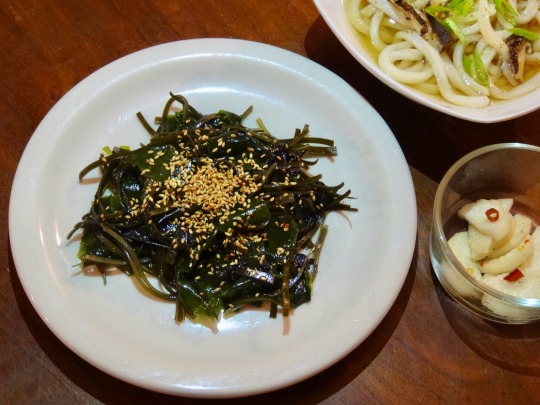
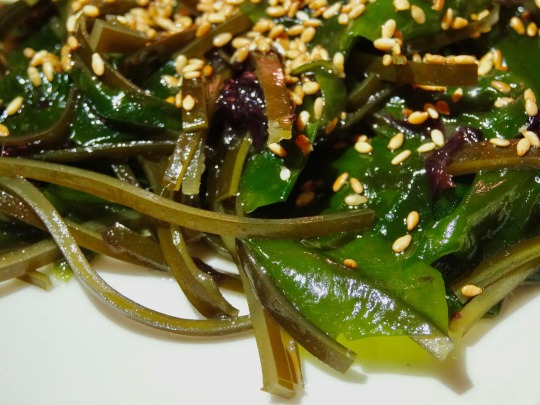
[ID: First photo shows a mixed seaweed salad topped with toasted sesame seeds; in the background are bowls of pickled daikon and kake udon. Second photo is a close-up showing light shining through the seaweed. End ID]
わかめと昆布サラダ / Wakame to konbu sarada (Seaweed and kelp salad)
A wide variety of seaweed-based salads are made by Japanese home cooks. They may contain only a mix of seaweeds and a dressing, but may also feature vegetables including cucumber, carrots, lotus root (レンコン / はす), daikon (だいこん), corn, edamame (枝豆), or onion. Dressings are as varied as cooks, and may be based around sesame oil (ごま油), rice vinegar (米酢), miso paste (みそ / 味噌), ponzu sauce (ポン酢), or mayonnaise (マヨ).
This recipe is a good way to use up reconstituted kombu and wakame that were steeped to make soup stock. It includes instructions for two dressings: one based on rice vinegar and sesame oil, and another with a sesame-mayo base.
"わかめ" or "ワカメ" ("wakame") is likely from "若" ("waka," "young") + "海布" ("me," "seaweed"); it is a particular species of edible seaweed (Undaria pinnatifida) that is farmed in Japan, Korea, and China. It is sometimes called "sea mustard" in English. Without further specification, "wakame" in a culinary context is taken to mean the leaves of the seaweed; these are the same leaves that are eaten in miso soup (みそ汁).
The etymology of "昆布" ("kombu" or "konbu") is unknown. It may be a phonetic Japanese reading of the Middle Chinese "昆布" (Mandarin: "kūnbù") (itself from "綸布" "*krūn pās," "green ribbon" + "cloth"), used to refer to various types of kelp and seaweed. In Japanese, the term refers to any of a few species of edible kelp from the Laminariaceae family.
Dried kombu is steeped to make one type of dashi ("出汁" / "だし"), a stock that is used in various soups and sauces. Once reconstituted, it may be steeped again to make 二番だし ("niban dashi," "second dashi"), sliced and simmered as one ingredient in a 煮物 ("nimono," simmered dish), or roasted and combined with other seaweeds and spices to make 振り掛け ("furikake").
"サラダ" ("sarada") is probably derived from the English "salad."
Note that the "seaweed salad" served at Japanese restaurants in the U.S. is not commonly eaten in Japan. It is shipped out to restaurants and stores pre-packaged, and is made with colored オゴノリ ("ogonori"; "agar" on ingredients lists), きくらげ ("kikurage"; "wood ear mushroom" or "fungus" on ingredients lists), and byproducts of wakame including 茎わかめ ("kukiwakame," wakame stem) and メカブ ("mekabu," wakame sprouts; both listed as "wakame" or "seaweed" on ingredients lists). You may be able to find this salad in the freezer section of your local Asian grocery store. If you want to approximate the texture of this salad at home, try buying some mixture of ogonori, kikurage, kukiwakame, mekabu, モズク ("mokuzu"), and/or ひじき ("hijiki"). Instructions for the dressing are below.
Recipe under the cut!
Patreon | Paypal | Venmo
Ingredients:
For the salad:
2 cups total reconstituted kombu, wakame, hijiki, or other kelp or seaweed
Vegetable additions to seaweed salads are possible and common. Try adding some cucumber, julienned carrots, sliced lotus root, sliked daikon radish, corn, edamame, or sliced onion that's been soaked in plum vinegar for 15 minutes.
If you're including cucumbers, slice them, salt them, allow them to drain in a colander for about 10 minutes, then gently squeeze them of excess liquid, to avoid making your salad watery.
For dressing 1:
1 Tbsp unseasoned rice vinegar (米酢)
1 Tbsp toasted sesame oil (煎りごま油)
1/2 kosher salt
1/2 tsp vegetarian granulated sugar
1/2 tsp Japanese soy sauce (しょうゆ / 醤油) (such as Kikkoman's)
2 tsp toasted sesame seeds (いりごま)
To make U.S. restuarant-style seaweed salad, omit the soy sauce; replace the sugar with high fructose corn syrup; and add a pinch of cayenne pepper, 1/4 tsp of onion powder or yeast extract, and a pinch of MSG.
For dressing 2:
2 Tbsp vegan mayonnaise
1/2 tsp unseasoned rice vinegar (米酢)
1/4 tsp dried ground shiitake mushroom, or vegetarian dashi powder
1/4 tsp vegetarian granulated sugar
Drop of djion mustard
Pinch kosher salt
1 tsp Japanese soy sauce (しょうゆ / 醤油) (such as Kikkoman's)
Drizzle of mirin (みりん)
2 tsp toasted sesame seeds, ground in a mortar and pestle or spice mill
If you eat eggs, you can replace the first five ingredients with 2 Tbsp Kewpie mayo (キューピーマヨ).
For a halal version, replace the mirin with an extra pinch of sugar.
Instructions:
For the salad:
1. Slice kombu into very thin strips. Slice wakame into thin strips, or leave as-is, as desired. Slice other flat dried seaweed into thin strips or bite-sized pieces.
For dressing 1:
1. Whisk all ingredients except sesame seeds together in a small bowl. Toss with seaweed. Top with sesame seeds and serve cold.
For dressing 2:
1. Whisk all ingredients together in a small bowl. Toss with seaweed. Serve cold.
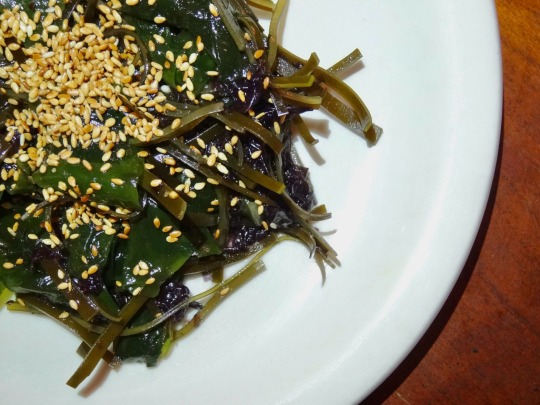
71 notes
·
View notes
Text
Sharing my new favorite scrambled egg recipe. Originally from yt shorts but I modified it slightly
Tools:
Bowl
Spoon or fork
Non stick pan
Stove
Ingredients:
2 eggs
2 tbsp of milk
Pinch of salt and pepper
½ tbsp of sweet soy sauce
½ tbsp of oyster sauce
1 tbsp of sesame oil (or you can use 1½ if you're really into sesame oil like I am lol)
Butter (amount depends on your pan size)
Nori/seaweed (optional)
Steps:
Preheat a non stick pan to medium-high heat
In a bowl, crack 2 eggs. Do it VERY carefully because you can accidentally break the yolk too if you're not careful. Best result is with the yolk intact.
Add 2 tbsp of milk, pinch of salt and pepper.
Using a spoon or a fork, mix the egg whites, milk, salt and pepper VERY CAREFULLY. Again, best result is with the yolk intact.
After the pan is hot, add some butter. The amount depends on how big your pan is. I have a 22 cm pan (≈8.6 inches) so I use about ½ tbsp. You just want enough butter to evenly cover the entire pan.
Pour the egg mix in. Let the egg whites cook for about 1 to 2 minutes.
Scramble ONLY the egg whites for now. You want to form them nicely around the yolks. This process can be made easier if you tilt the pan to one side.
Now add sweet soy sauce, oyster sauce and sesame oil.
Now break the yolks! And scramble the entire mix nicely and evenly. Cook for about 3 to 5 minutes.
Remove from heat and serve warm. Top with nori/seaweed if desired.
12 notes
·
View notes
Text
nostalgic food
i’ll want to reference this in the future

gỏi cuốn (spring roll with chicken, egg, rice noodle, carrot, lettuce, avocado)
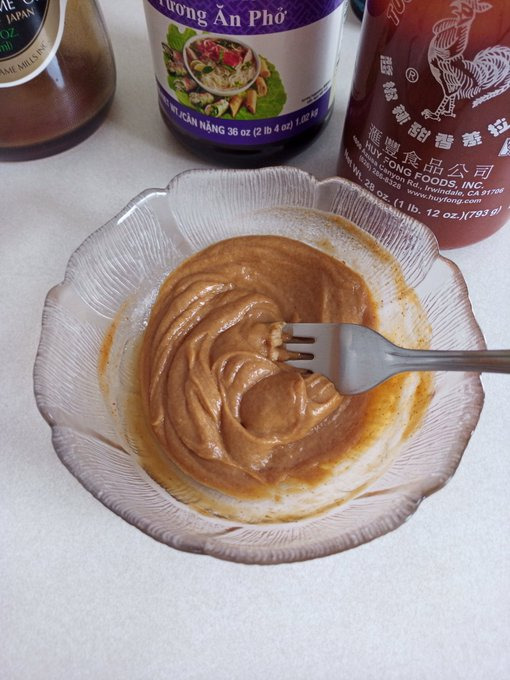
peanut sauce is just peanut butter+water, hoisin+sriracha sauce, and a tiny bit of sesame oil (tastes good with almost anything imo)
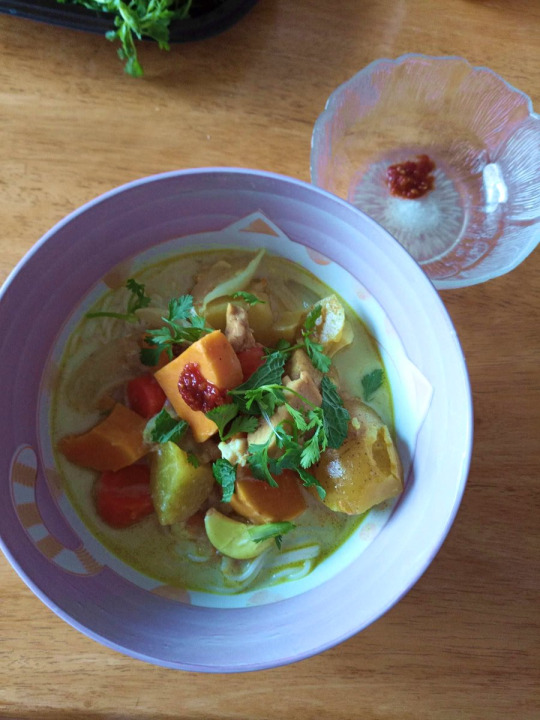
yellow curry
rice noodle with chicken, potatoes, yams, onions, carrots in a creamy coconut milk and yellow curry paste broth
lemon juice and salt mix with garlic chili for dipping

bò kho (vietnamese beef stew)
kho is a cooking technique where a protein is braised in a mixture of fish sauce, sugar, and water or coconut juice to make a salty/savory result
bread dips in stew beef/potatoes dip in lime juice/salt/pepper mix
cucumber slices to offset the salty
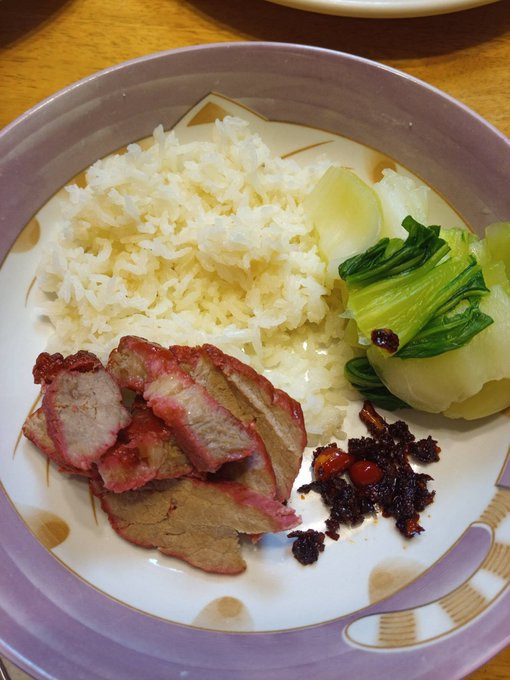
xá xíu (cantonese style bbq pork)
the seasoning mix is made of sugar, powdered soy sauce, onion and garlic powder, and spices
the pink color very much freaked out middle schoolers at lunch

cơm tấm (broken rice, grilled pork, egg, pickled carrots/daikon with scallions/oil garnish and fish sauce)
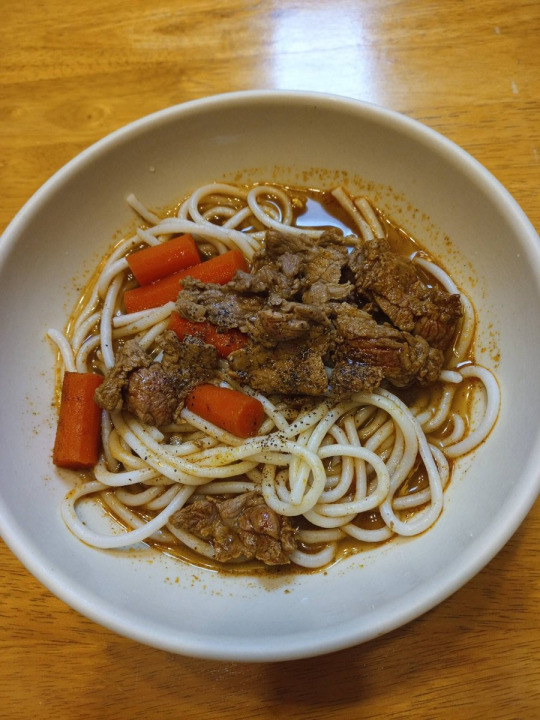
bún bò huế (thick round rice noodle with beef soup)
more "fun" than phở imo
bún bò broth: spicy salty flavor (lemongrass, spicy chili, fermented shrimp paste, fish sauce)
phở broth: earthy sweet flavor (cinnamon, star anise, onion, ginger, garlic, herbs)
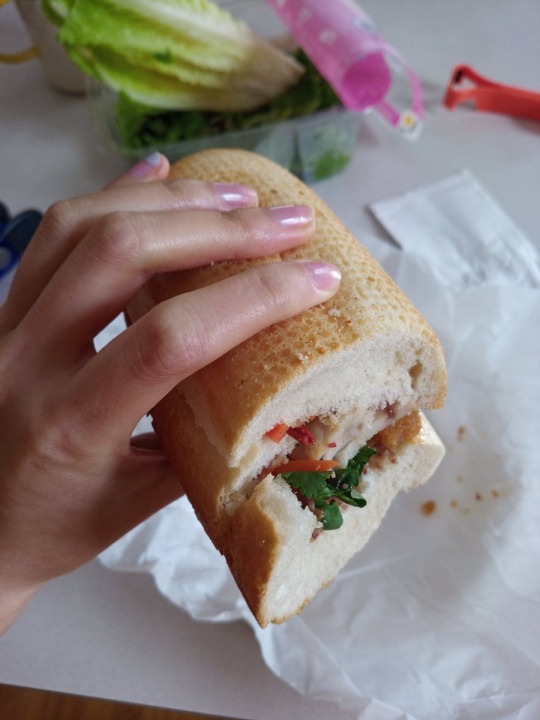
bánh mì (baguette sandwich with chả lụa (pork sausage), xá xíu (cantonese style bbq pork) coriander leaf (cilantro), cucumber, pickled carrots, and pickled daikon combined with pâté and buttery mayonnaise)

salmon instead of nem nướng̣ (viet grilled pork) with bánh hỏi (rice vermicelli)
feat nori (dried edible seaweed)
wrapped with lettuce and dipped in nước mắm (fish sauce)
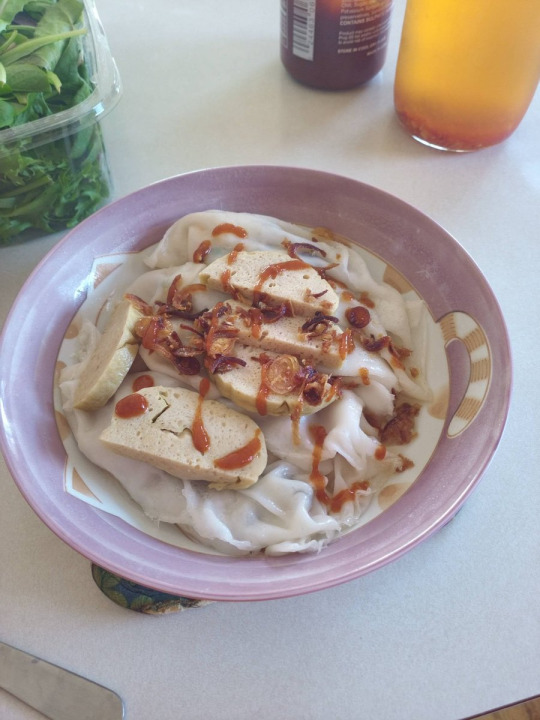
bánh cuốn (rice noodle rolls filled with ground meat, wood ear mushrooms, onions)
topped with chả lụa (pork sausage) and fried red onions and nước mắm (fermented salted fish sauce)
a fav of grandpa's
pizza man mispronounces it as "bun goo" which makes my mom giggle cause the way he says goo sounds like penis

bánh tét (glutinous rice rolled in a banana leaf into a thick, log-like cylindrical shape, with a mung bean and pork filling)
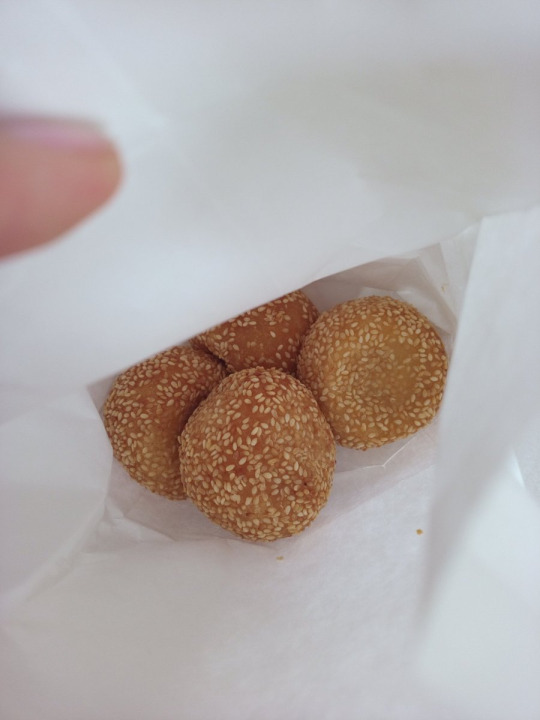
bánh rán (deep fried sesame ball filled with mung bean)
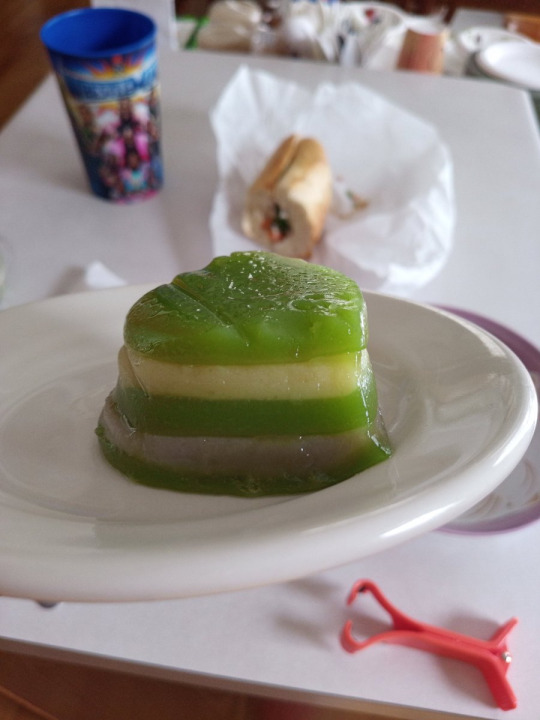
bánh da lợn "pig skin cake" (tapioca starch, rice flour, mung bean, taro, coconut milk)
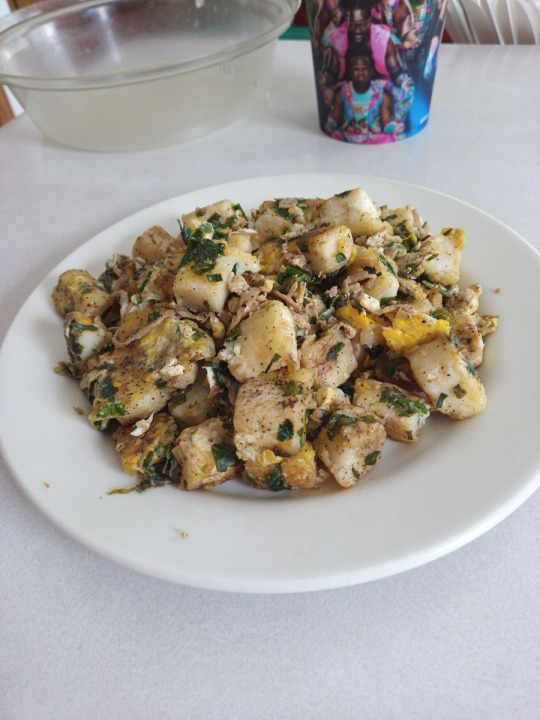
bánh bột chiên (fried taro rice cake, a fav of pizza man)

phở (broth: earthy sweet flavor- cinnamon, star anise, onion, ginger, garlic, herbs)
ive called phở mid but while eating this i was like huh this is good actually then my dad says this time he simmered chicken bones for hours like he's supposed to instead of using canned broth
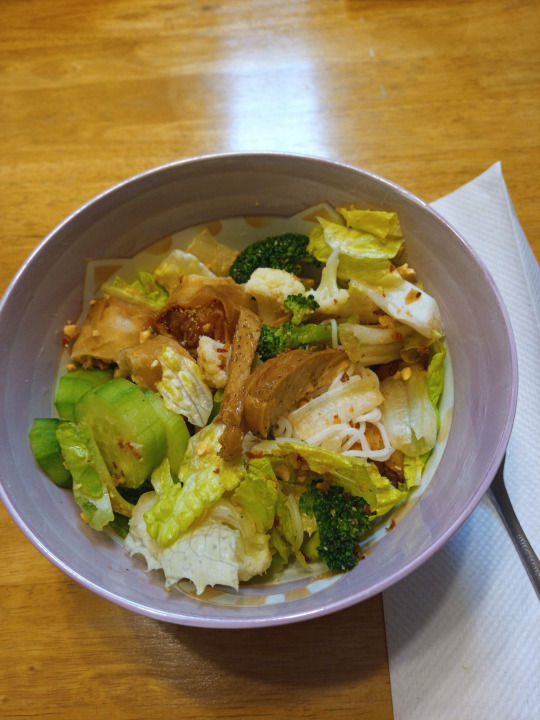
improvised bún thịt nướng (rice noodle bowl with chopped grilled pork, egg roll, veggies, crushed peanuts, fish sauce)
a way to deal with leftover noodles from gỏi cuốn
every time i eat this i think of the time me and pizza man were in new orleans and he asked if i wanted to eat at a viet place and i was surprised cause he's not really into a lot of viet food but anyway i got bún thịt nướng

thịt kho (pork with eggs braised in sticky savory caramel of sugar, fish sauce, coconut water)
i have distinct flashbacks of being in the middle school cafeteria with my thịt kho and kids around me going "what is that??", "ewwww" lol
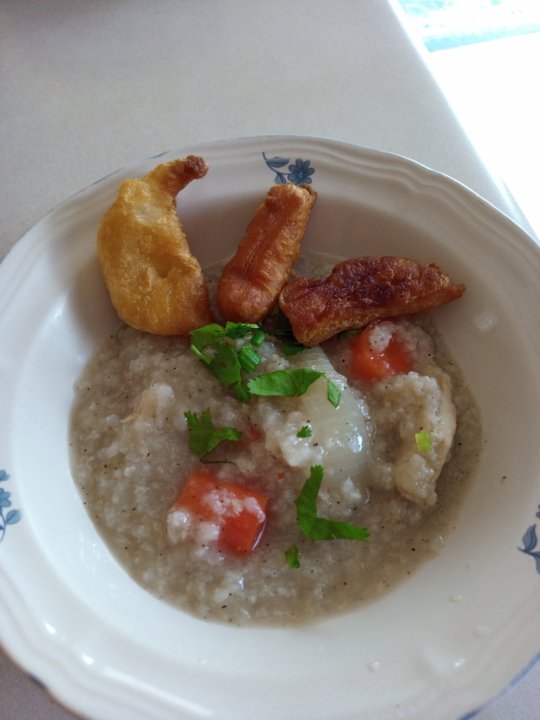
cháo (rice porridge with chicken or a white meat fish- often served with crunchy cabbage salad)
my dad likes it with youtiao (chinese donuts)
being sick means eating this! but we also eat it a lot when we’re not sick!
when my mom was young she would say yes to any dude that asked her out and order an obscene amount of food/the most expensive things on the menu and never hear from them again but my dad took her to a cháo place cause that was his favorite but apparently for cheapskates
he proposed two weeks later and she said yes
my mom is such a menace i wanna be just like her
70 notes
·
View notes
Text
My unorthodox Yangchunmian noodle soup/阳春面
(This is the reason why I was rendering lard lol)

Homestyle unorthodox Yangchunmian noodle soup recipe (enough for 1 person but must be served in a big ramen bowl) (Note: this version includes pork fat and is therefore not vegan/vegetarian/halal/kosher):
Ingredients (optional ones marked with *):
Noodles (preferably thin)
Egg
Soy sauce
Cooking oil
Pork lard (preferably rendered following the recipe that includes baijiu/green onions/ginger; if not, there are brands out there that can imitate the taste)
Pyropia seaweed (this is what nori is made from so unseasoned nori is also fine; also sold dried in giant discs)
*Wakame (brown kelp) OR Shanghai bok choy (stem is green instead of white) OR dried shiitaki mushrooms
Green onion
Chinese black vinegar (the one I used is Duliu Laocu/独流老醋, Zhenjiang Xiangcu/镇江香醋 is also fine)
Ground white pepper
Sugar
*Salt
Sesame oil
*Fish sauce/鱼露
*Chicken bouillon powder
Preparation:
Chop green onion, just one will do
Tear off a 2"x2" piece of pyropia seaweed OR 2 small pieces of nori
*If adding bok choy, wash bok choy
*If adding dried shiitaki mushrooms, rehydrate it first
In a ramen bowl, add:
~4 tbsp of soy sauce
~3/4 tsp of pork lard
~1 tsp of Chinese black vinegar
*A few drops of fish sauce
~1/2 tsp ground white pepper
~1/4 tsp sugar
*~1/4 tsp chicken bouillon powder
~1/2 tsp seasame oil
Pour just enough hot water to melt pork lard and combine everything together, mix well
In a sauce pan (at least 1.5 qt):
Turn on heat, set to medium
When pan is hot, rub the pyropia seaweed on the bottom of the pan a couple of times to mimic toasting, then put seaweed into ramen bowl
Pour a little cooking oil into pan, fry the egg until over hard
Add 5 cups of hot water into pan
Add noodles, *add bok choy
Let it cook
*When noodles are halfway done, add the vegetable (wakame/shiitaki mushroom) as desired
When noodles are done, pour everything into bowl, mix well with the soup base in the bowl
*Add salt as desired
Top with fresh chopped green onion and serve
The end product should taste mildly salty, mildly sour, and umami. Overall taste should be mild.
#the reason the soup looks more like the soup in ramen is because I fried the egg before boiling it with the noodles#frying anything before making soup out of it will make the soup more opaque#the traditional version uses homemade clear chicken stock but aint nobody got time for that#chinese cooking#chinese food#recipes#yangchunmian#阳春面
12 notes
·
View notes
Text


Maruchan soy sauce ramen with the usual toppings (green onion, sesame oil, sesame seeds, and coarse salt) with some wakame seaweed.
2 notes
·
View notes
Text
Yi Ti Cuisine:
Breakfast consists of a soup or stock, seasoned with scallions or chives, sweet basil, salt and pepper, and then vegetables like chopped carrots are added alongside egg noodles. Some choose to eat a fried egg on top of their soup, but this is usually done in the northern provinces. Drink in the summer is traditionally a heavy red tea flavored with citrus or saffron if you can get it.
Lunches differ depending on the region, in the south, a common dish is that of rice seasoned lightly with pepper and crushed dried seaweed, side of fried fish topped with chopped chives and salt and pepper, served with a dipping sauce of sesame oil. While in the north, a wheat berry and oats porridge is topped with breadcrumbs and a side of auroch meat strips grilled with salt and pepper is seen as a filling lunch.
Enjoyed for either lunch or dinner, shredded goat or lamb meat is seasoned lightly with salt and pepper and then filled into a thin grain-dough wrap, alongside finely chopped cabbage, scallion, carrots, and ginger. A sauce made of sesame oil and a dash of rice vinegar alongside small bits of crushed garlic is available to dip the roll into. Alternatively, this dish can be enjoyed in a soup, often in a chicken stock that in preparation has garlic and ginger in it, but when reaching boiling point the larger pieces are taken out. Otherwise seasoned with chopped chives and coriander, and added for texture is a small bundle of egg noodles.
For dinner, an easy to make meal is a whole chicken or pheasant gutted but not deboned, and then stuffed only halfway with a mix of scallions, leeks, ginger, salt and pepper. The chicken is marinated in a pot of its own juices and a splash of boiled water with added seasonings like soy sauce, a dash of cane sugar and rice wine. The chicken is then cooked in a covered pot over a flame. The finished product is served with boiled cabbage and carrot covered in finely chopped bits of garlic and salt to taste.
A species of small kraken makes its home in the Jade Sea. Reaching a size no longer than that of a man’s forearm and hand, the body of the kraken is only truly about a quarter of that size, with its tentacles making up the length of it. The color is a sickly pale gray-pink with yellow-green eyes, but when cooked the meat turns a clean white color. Common dinner cuisine in the south, especially in port cities, dictate that the eye and beak portion of the body be cut from it and the tentacles. The mantle of the kraken is gutted and then stuffed with crabmeat and diced shrimp. That filling is then seasoned with pepper, ginger, a pinch of cinnamon, occasionally garlic if desired, and then the open end is stuck shut with a small pick. The mantle is deep fried in an egg yolk and breadcrumb batter, alongside the tentacles seasoned only just with salt and pepper, and then plated on a dish covered with light cloth to soak up the residue oil. A dipping sauce of either rice vinegar or soy sauce with sesame seeds added in is offered, and sprinkled sparsely over the meat is shredded basil.
Tulao—a sweet, soft cheese able to be spread with a knife across pastry. Take a spoon and scoop the cheese out onto a small plate. Place beside it four pitted and divided cherries, preferably tart to bittersweet ones found in the southeastern provinces of Yi Ti, and slices of a ripe peach to surround the cheese. Drizzle over it rosehip syrup or cane syrup at choice.
During winter periods, especially in the northern provinces of Yi Ti, it is common to see people enjoying Yanmo, which is a delicious dessert made of goat milk heated and mixed with honey and waxberry syrup, for rosehip syrup is too sparse and difficult to find without scam. This is mixed until dissolved and then left to cool completely, and then poured over a heaping of shaved ice and eaten with a small spoon.
Often drunk in winter, the popular choice of drink is either fermented cows milk spiced with cinnamon and occasionally honey, or that of Pinjui. It is a mixed drink, part cider and rice wine; only made during the cold season in Yi Ti. Dried, good shaped apples still surviving after the first frost are picked from the tree and processed, then put underground for 3 months to ferment halfway. The Pinjui produced is then added to steamed rice alongside a spiced yeast-water mixture, and left to further ferment for another 4-5 months. The resulting Pinjui has a savory-sweet flavor that warms the body, with hints of caramel and a faint aftertaste of sour apple.
For the eccentric in the winter that want to fight the biting cold of the world with a chilled drink of their own, ice cider is preferable. Fresh and sweet, it offers less of the spreading warmth that Pinjui does and more of a blood pumping sensation not unlike that of chewing mint and then eating snow would.
Golden wine from Yi Ti is medium-bodied and made from the versatile Subi grape selection. Many golden wines can taste similar due to the usage of these grapes, but differ vastly in aftertaste and small flavor notes; all depending on where they are grown and processed. In the northeastern provinces it has a subtle bite of sourness. In the south to some south-western regions, the wine doesn’t hold quite the tart kick of its neighbor in the eastern provinces, it still has enough to be a refreshing summer wine served coast side. Rarely found now in the further west of Yi Ti, the few golden winemakers differ from their competitors in the other provinces with their golden wines being full-bodied, and producing a heavier coloring than the others, often becoming closer to amber than gold due to production varying wildly with how few golden winemakers are left, and how closely they hold their secrets. These golden wines often hold strong hints of safflower, and would be termed in Westeros more likely as strongwine[1] than golden wine, given their flavoring and coloration compared to that of the other wines made using Subi grapes. The largest producer of wines in Yi Ti is the Luma Province.
Strongwine = fortified wine (wine mixed with spirits like brandy)
-
to hold the tide while I wade through molasses;
sauce
45 notes
·
View notes
Text
How to Make Homemade Sushi Rolls
New Post has been published on https://thekitchnpro.com/how-to-make-homemade-sushi-rolls/
How to Make Homemade Sushi Rolls

What can we say about sushi rolls that haven’t already been said? It’s healthy, it’s delicious, and best of all, and it’s endlessly customizable! No matter how long you’ve been in the kitchen, there are always new skills to master when it comes to this classic dish. Even better, sushi doesn’t have to be intimidating or difficult—just follow these steps to get started with your own homemade sushi rolls!
Things you will need
-Rice Cooker
-A bamboo rolling mat
–Two long-handled wooden chopsticks
-Nori (seaweed) sheets -Dried Seaweed (optional)
-Sushi rice (approximately 1 cup per roll, preferably made with short grain rice)
Buy Now!
Step One:
Prepare your ingredients. The first step in making sushi rolls is acquiring all of your ingredients. These include but are not limited to salt, sesame seeds, Nori sheets, raw fish and various vegetables for toppings. Begin by preparing a large pot of boiling water. Once you add your sticky rice it should be boiled on a high heat for five minutes before being turned down slightly and simmered on a low heat for another 10 minutes while covered with a lid.
While your rice is cooking, prepare whatever vegetables or meats you intend to use as a topping. When you can see that there are only three minutes left on your timer, remove the lid from your pan, turn up its heat slightly and stir continuously until steam rises through holes placed in the center of its surface.
This will help ensure an even consistency throughout each sheet of sushi when rolled later. Sticky rice will now need to cool completely for approximately 30 minutes so line a surface below with cling film which has been lightly dusted with either white or brown sugar depending upon whether you’re making sweet or savory rolls respectively.
Next, place half a teaspoon of oil into your hands along with some salt and dip each individual grain of rice individually. This process will prevent any grains from sticking together once cooked, improving both taste and appearance alike. Using these same hands push aside any grains towards one side of your mixing bowl while pouring additional cold water over them if needed until they’ve reached room temperature.
Now, pour these cooled grains onto your prepped working surface where they’ll be easier to work with. If your sushi involves a filling such as a tuna then slice it thinly prior to placing it atop your rice. Vegetables should also be sliced into thin strips after being rinsed thoroughly with cool water. If desired, sprinkle extra toppings such as sesame seeds or soy sauce prior to wrapping before using cling film to seal each roll tightly yet gently.
Store them in your refrigerator once completed for at least two hours; however they can remain wrapped for around four hours without issue. Other recipes may call for a simple layer of mayonnaise or a small pat of butter atop your rice instead. Be sure to make a double batch since it never lasts long! Before cutting, allow your sushi to come back to room temperature unless stated otherwise.
Buy Now!
Step Two
Preparing your fillings. In most cases, sushi chefs choose to use seafood with their uncooked fillings since most types of meat do not generally take well with uncooked rice. However, most types of seafood do, especially those prone to spoiling quickly such as shrimp and squid. While whole shrimp must always be peeled prior to tossing them within rice others like mussels should simply be removed from their shells before dipping within the rice. After dipping, ingredients such as cucumber and avocado can be used to top your rolls. This is done prior to rolling as these ingredients will not hold up well with rice or seaweed.
Buy Now!
Step Three
Roll your sushi. As you begin to create each roll, use a rectangular piece of plastic wrap (cling film) and lay it out flat on a smooth surface. Covering much of its surface with a moist paper towel prior to adding rice is recommended for best results, helping reduce its likelihood of drying out during storage after being wrapped in it.
To begin each roll, begin scooping rice from your mixing bowl into your hands until you have enough to cover much of its surface area evenly. This is referred to as a rice ball. The amount of rice you use should be relative to how thick you want your rolls to be. If you want them thick, use a little more rice. If you want them thin, useless.
Once ready, begin flattening out your rice ball until it resembles a rectangle in shape. Place your chosen ingredients evenly atop its surface and bring up opposite sides from its corners until it touches itself from opposite ends. Your ingredients will now be in a vertical line in between these sides while positioned horizontally on each end of it. At last, roll up your fillings horizontally in between these sides while squeezing any excess air within their center away from its edge for best results. Repeat with the remaining ingredients to complete your sushi rolls.
Buy Now!
Step Four
Preserve your sushi rolls. For best results, wrap each of these rolls in clear cling film (plastic wrap) before storing them in your fridge for no longer than 48 hours. If you’d prefer to freeze them, it’s best to do so immediately after completing their creation for the best results since they don’t do well at room temperature or warmer temperatures once frozen. This is due to rice swelling as it thaws, losing its texture, and becoming overly soft with extended exposure to warm conditions compared to seafood items which are better suited for freezing. Frozen sushi can be stored for up to three months.
Buy Now!
Step Five
Slice your sushi rolls. Although you could eat your sushi as is, most people will want to cut them into smaller pieces prior to consuming them. This can be accomplished by first removing their cling film (wrap) and slicing their roll with a knife atop a clean surface such as wood or marble rather than directly on your countertop or table which may become stained from its oils/flavors after time and ruin its finish if not cleaned afterward.
When creating these slices, it’s best to use a gentle rocking motion at first while applying light pressure until you feel that all of its ingredients are beginning to separate before pushing harder until they do so uniformly into equal-sized pieces. Don’t forget to remove any leftover bits of rice as well as its nori (seaweed) from your roll before doing so.
Now, Serve and enjoy your sushi rolls!!
2 notes
·
View notes
Text
Did not get restful sleep last night. Finally fell asleep close to 3am. Unfriendly was up at 5 ish. I woke up at 5:30 ish and again at 6:15 to tell him bye. Had a couple of toaster waffles with peanut butter and honey and tried to go back to sleep. Woke up at about 2 pm because of the lawn guys.
I've been dreaming a lot when I do sleep but I can't quite remember what. It's a jumble.
I have rice ramen so I made that and my broth was chili oil, sesame oil, salt, pepper, garlic and something I found I think at Kroger called Kimchi Kick seasoning. I topped it with roasted seaweed snacks I crumbled. I basically require spicy broth with this damn cold. Earlier versions included shredded rotisserie chicken. So good!
I actually ventured outside today to get the mail. Did some dishes. Took a shower. Scooped Gigabyte's litter boxes and changed her water.
Had an appetizer dinner with Unfriendly. He had a retina doctor appointment today so he's in a dark room now. I can't talk a lot. He can't see well. We're quite the pair today.
I'm just waiting on Gigabyte's fluids to cool down. After I medicate her I'm going to try to sleep. I feel the kind of tired like when you spend a good six hours of errands / shopping on a busy day but I've barely moved.
39 notes
·
View notes
Text
For @starblue2406
Here are a few things I'll eat in a day. I typically don't eat a big breakfast, but I will have a big lunch. Dinners in my family are late, usually 6pm to 8pm, we typically walk after dinner, then I'll drink tea to relax before bed.
You'll probably notice a lack of beef and pork, I have trouble digesting them, so it's mostly chicken and seafood. My family also don't eat a lot of bread, it's treated more like a side than a meal.
And yeah, there's a quite a mix of cultures here. My mom's side is Greek/Egypt with Turkish influences from her great grandfather, my dad is Native American with some adopted local New Mexico flavors. Since I was originally born and raised by the ocean, seafood and sea vegetables are a big thing in my diet. They're hard to find in the southwest, but I crave them and they keep me healthy as I have low blood pressure, so I need a bit of healthy salt.
----------------
Things I'll have for breakfast:
Apple cider vinegar mixed with honey or a fruit juice, usually pomegranate juice. Gets my digestive system prepped.
Oatmeal with dates, pumpkin seeds, and seasonal fruit.
Fresh fruit or fruit jelly with yogurt. I like Greek yogurt as it's more creamy and filling.
Seaweed soup with green onions or salmon
Kefir a type of strong yogurt drink
Crepe with fruit, pine nuts and honey
Omelet with spinach or dandelion greens
Eggs boiled in black tea and star anise
Shakshuka eggs with tomato and spices
Salmon with fried eggs
Fresh tilapia corn taco
Fruit smoothies
Green tea
Yerba mate
Lunch:
A Flatbread wrap with either chicken or falafel, lettuce, feta, red onion or tomato topped with tzatziki or Tahiti
Sardines with tomato pesto on ciabatta
Basmati rice with chicken or fish with garlic, oregano, basil
Tuna with red onion and chopped mozzarella
A salad made of lightly pickled cucumber and lato (sea grapes)
Rice soup - Made with leftover tea, seaweed, sesame seeds, fish
Baby octopus with chopped tomatoes, red onion, and oregano -
Dolma - Grape leaves stuffed with spiced rice and a meat then steamed, cabbage leaves are sometimes used instead
Ta'meya or Falafel - ground chickpeas or lentils mixed with spices and fried into rounds, topped with tzatziki or hummus
Grilled cheese with strawberry and sage
Jellyfish salad with sweet vinegar and red chili
Steamed cactus pads with watermelon rind
Blue corn bread with sweet corn
Fish cakes in a crab broth with five spice seasoning
Ful medames
Peel and eat shrimp
Mussels on ice
Shawarma
Dinner:
Grilled chicken with mixed vegetables like cherry tomatoes
Vegetable bake with seasonal vegetables
Eggplant lasagna with feta and sliced tomatoes
Cioppino - Seafood in a rich tomato broth
Risotto rice with mushroom
Shrimp with feta and tomatoes
Grilled catfish with spices
Mussels in butter and garlic
Seafood in spiced yellow rice
Crab cakes in scallop shells
Three Sisters soup - Corn, beans, squash
Spinach and cheese stuffed pastries
Squash and corn simmered in milk with pepper, garlic, and saffron
Pumpkin soup with garlic, apple, and sweet potato
Tuna steak with cranberries and feta
Zucchini stuffed with herbed rice and baked
Sayadeya - Fried fish with red onions on rice spiced with cinnamon, turmeric, and ginger
Venison chili beans
Fry bread tacos
Kushari
Chicken livers and hearts
Wild rice with elderberry and morel mushrooms
Lumpias - Like a large egg roll
Wild rice with sweet potato, pumpkin, and cranberry
Snow fungus soup with chicken bone broth
Chicken herb soup - chicken boiled with red dates, wild yam, astragalus, goji
Grilled chicken with butternut squash sweet potatoes
Mixed bean soup with chicken bone broth
Sweet and sour bitter melon soup
Between meals:
Tea with milk
Lots of different nuts
Dried fruit like dates and figs
Fresh fruit with a bit of sweet condensed milk
Jerky turkey or venison
Pickled sweet vegetables
Bruschetta with crackers
Fresh figs with goat cheese
Olives stuffed with cheese
Seaweed salad
Squid jerky
Horned melon
Naan with olive oil
Fried sardines in honey
Mushroom chips
Sweet potato chips
Crispy baby crabs
Fried sage leaves
Prosciutto
Frozen grapes
Zabladi
Cactus fruit
Quail eggs
Snap peas
Drinks:
Grape juice
Pomegranate juice
Hibiscus tea
Mint tea
Ginger tea
Anise tea
Yuzu tea
Rose petal tea
Barley tea
Flowering tea
Mountain herb tea
Water infused with fresh lemongrass and fennel
Water with basil seeds with honey
Roasted milk tea
Yerba mate
Corn silk tea
Rice milk with cinnamon and cardamom
Desserts:
Yogurt with honey and mixed fruit either frozen or seasonal
Chia pudding with peanut butter or rose petal jelly
Italian soda with sugar-free syrups of either rosewater, lavender, peach, or strawberry
Iced coffee with cacao nibs
Chocolate dipped fruit
Gelatins
Anise cookies
Amaretto biscuits
Honey comb
Baklava
Grass jelly with milk
Coconut milk pudding
Rose or pistachio halva
Sweet potato with ice cream
Snow fungus with fruit and rock sugar
Khoshaf - A dessert made of dried fruits simmered with cinnamon, nutmeg, and cloves
Lazy meals:
A typical salad
Frozen vegetables popped into a microwave and served with ready cooked shrimp or a can of sardines in tomato
Pumpkin puree in a can mixed with garlic, pepper, and milk pop into microwave
Jellyfish salad with pickled vegetables and sweet chili sauce
Thin crust pizza made from a pita with tomato, cheese, and Italian seasoning
Spinach or dandelion greens omelet with cheese
Rice soup - made with tea, fish, seaweed, and green onion
Sweet potato with toppings of choice
Baked potato with peanut butter and crab paste
Wonton wrappers stuffed with cream cheese and fried
Chestnut rice - Rice with chopped chestnuts
Chopped apples with cinnamon and honey in the microwave
Bread pudding - day old bread, fruit of choice, egg, milk pop in microwave until egg is cooked
Rice pudding - cooked rice, milk, cardamom, cinnamon, and dried chopped fruit
#What I typically eat#I love to cook so I make a lot to reheat later#Saves me a lot of prep time especially rice or beans#I'm aware some of these ingredients are off putting lol especially Jellyfish and snow fungus but they're delicious
4 notes
·
View notes
Photo

Ochazuke (Green Tea Over Rice) お茶漬け
https://www.justonecookbook.com/ochazuke/
Ingredients
1 Japanese Salted Salmon (homemade or store bought) (or ½ fillet of salmon and a pinch of salt for 1 serving)
1 cup cooked Japanese short-grain rice
1 tsp bubu arare (crispy puffed rice pellets) (or use crushed Japanese rice crackers; it's a bit expensive, but you can buy bubu arare on Amazon)
1 tsp shredded nori seaweed (kizami nori)
¼ tsp toasted white sesame seeds
2 sprigs mitsuba (Japanese parsley) (you can substitute trefoil or ⅛ scallion for 1 serving, cut into small pieces)
wasabi (optional, to taste)
For Ochazuke with Dashi (picture on the left):
1 cup dashi (Japanese soup stock; click to learn more)
1 tsp mirin
1 tsp soy sauce
⅛ tsp kosher salt (Diamond Crystal; use half for table salt)
For Ochazuke with Green Tea (picture on the right):
2 tsp Japanese green tea leaves (I used genmaicha, but sencha, hojicha, and mugicha work as well; 3 g (1 tsp) tea leaves for 100 ml (about ½ cup) hot water)
1 cup hot water (see the tea package for appropriate temperature for your tea leaves)
½ tsp soy sauce (optional)
Instructions
Gather all the ingredients.
To Prepare the Ingredients
Preheat the oven to 425ºF (218ºC). For a convection oven, reduce the cooking temperature by 25ºF (15ºC). Bake the salted salmon fillet (shiojake) for 20-25 minutes until the skin and flesh are blistered and charred (Japanese salted salmon is always cooked until firm and well done). If you’re using regular salmon, season it with a pinch of salt and set it aside for 10 minutes before baking. When it’s cooked, remove the skin and bones and break up the salmon flesh into flakes. Set aside.
If you don’t have bubu arare, crush Japanese rice crackers into small pieces (you can also use a bag to crush it).
To Prepare the Dashi or Tea
Ochazuke with Dashi: Combine all the ingredients in a small saucepan and bring it to a boil. Pour the soup into a small teapot.
Ochazuke with Tea: Put the tea leaves in the pot. Bring the water to the appropriate temperature for your tea and pour it into the pot. Set aside for 1-2 minutes (follow the directions on your tea package).
To Serve
Now, place the cooked rice in the serving bowl. Place the flaked salmon on the rice and sprinkle the rice crackers, nori, and sesame seeds on top. Serve with tsukemono (pickles), such as Pickled Cucumber, as a part of the meal.
Ochazuke with Dashi: Pour the dashi into the bowl to cover half the rice and top with the mitsuba and wasabi. Enjoy!
Ochazuke with Tea: Pour the tea into the bowl to cover half the rice and top with the mitsuba and wasabi. Add the soy sauce, if you'd like.
For Ochazuke in Summertime
You can use cold rice and cold dashi or tea (I love mugicha or barley tea) in the summertime to enjoy a cool and refreshing version of Ochazuke.
23 notes
·
View notes
Note
Can you do a Glamrock Freddy sushi?
Glamrock Freddy Sushi Roll:
Ingredients:
- Sushi rice
- Nori (seaweed sheets)
- Yellowfin tuna or imitation crab
- Avocado slices
- Cucumber strips
- Black sesame seeds (for the black accents)
- Soy sauce, wasabi, and pickled ginger (for serving)
Instructions:
1. Prepare the rice: Cook sushi rice according to package instructions. Once done, season it with rice vinegar, sugar, and salt to taste. Let it cool.
2. Prepare the fillings: Cut the yellowfin tuna or imitation crab into strips. Cut avocado into slices and cucumber into thin strips.
3. Assembly: Lay a sheet of nori on a bamboo sushi mat. Spread a thin layer of sushi rice evenly over the nori, leaving a small border at the top edge.
4. Add fillings: Place the strips of yellowfin tuna or imitation crab, avocado slices, and cucumber strips horizontally across the rice.
5. Roll it up: Using the bamboo mat, carefully roll the sushi into a tight cylinder. Seal the roll by moistening the top border of the nori with a bit of water.
6. Finishing touch: Sprinkle black sesame seeds on top of the roll.
7. Slice and serve: Use a sharp knife to slice the roll into individual pieces. Serve with soy sauce, wasabi, and pickled ginger.
Remember, this recipe is about creativity and having fun, so feel free to adjust ingredients and quantities to suit your taste!
#video game#five nights at freddy's#spooky vibes#fnaf security breach#pizzaparty#fnaf movie#glamrock animatronics#glamrock#fnaf help wanted 2#glamrock freddy
6 notes
·
View notes